Ruby-Sapphire.com (original) (raw)
An over-and-underground look at the tanzanite mines of Merelani, Tanzania, where the First World meets the Third, and graphite-covered miners pull glittering blue gems from black earth.
Tanzanite Mines of Merelani • Working the Blueseam
The conquest of the earth, which mostly means the taking it away from those who have a different complexion or slightly flatter noses than ourselves, is not a pretty thing when you look into it too much. Joseph Conrad, Heart of Darkness
In much of the world, the haves and those not even close toil side-by-side, each with simultaneous desire and disdain for the other. Perhaps nowhere else on the planet are the contrasts as compacted as the few square kilometers that comprise the tanzanite mines of Merelani. This is where First World meets Third, a pressure-cooker that turns brown earth to blue jewels—where envy and avarice squeeze out of the graphite dust that coats all—black, white, and brown—in a sparkling mixture of blood, sweat and indigo tears.
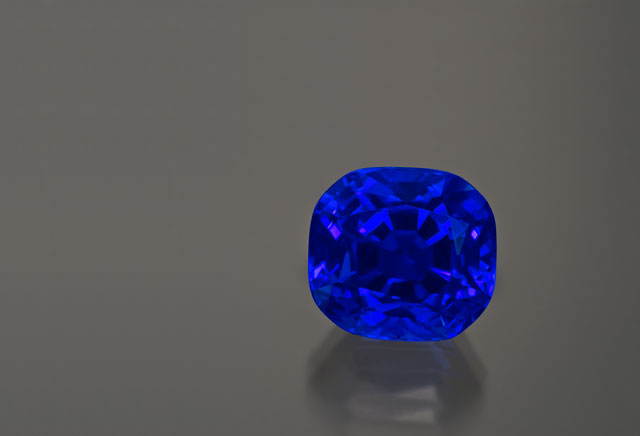 15.42 carats of deep blue wonder. The discovery of gems such as this set the world afire in 1967.
15.42 carats of deep blue wonder. The discovery of gems such as this set the world afire in 1967.
Photo: Wimon Manorotkul/Pala International; specimen courtesy of Robert & Phyllis Hughes
Blue lightning
Ever since Ndugu Jumanne Ngoma stumbled upon shimmering blue crystals in the shadows of Tanzania’s Mount Kilimanjaro, tanzanite has become one of the world’s most sought-after gemstones. No wonder. As anyone who has ever laid eyes on this gem can testify, tanzanite has a take on the blues that can drive even the finest sapphire to kick the nearest dog. And yet, when it was first discovered, Ngoma could hardly give it away:
I found the tanzanite in Merelani, Arusha, in the area called Kiteto at the beginning of January 1967. I was on my way to visit some of my relatives who live in Kiteto, when walking through the bush I saw some crystals of a blue mineral lying on the ground. There were very nice… They were blue, some were transparent… In a few hours I collected about 5kg — they were all very lovely blue crystals.
A friend told me to get on the bus and go to Nairobi… where there was a much bigger gem market than in Arusha. So I borrowed some money for the journey and went to an overseas company who deals in precious stones… and I let them see the 5kg of tanzanite. They didn’t even know what the mineral was. They told me, though, that as soon as they knew, they would let me know. I left them with the 5kg of tanzanite in exchange for a return ticket home, worth $5.… 33 years have gone by and I’m still waiting for their answer! But I kept some samples for myself.
– Ndugu Jumanne Ngoma, relating his discovery of tanzanite to author Valerio Zancanella
Following this discovery, tanzanite quickly became one of the world’s most popular gemstones. Some credit is due to Tiffany & Co., who introduced it to market with a lovely name that pays tribute to the beauty of the land of its birth. Tiffany understood that to call this glamorous gem by its mineral name, blue zoisite, would not do it justice.
Today tanzanite is available in a variety of shapes and sizes. Rarely pure blue, tanzanite almost always displays overtones of violet. In smaller sizes, it tends toward lighter shades of lavender and periwinkle, while in sizes above ten carats, tanzanite can show richer, more intense blue colors.
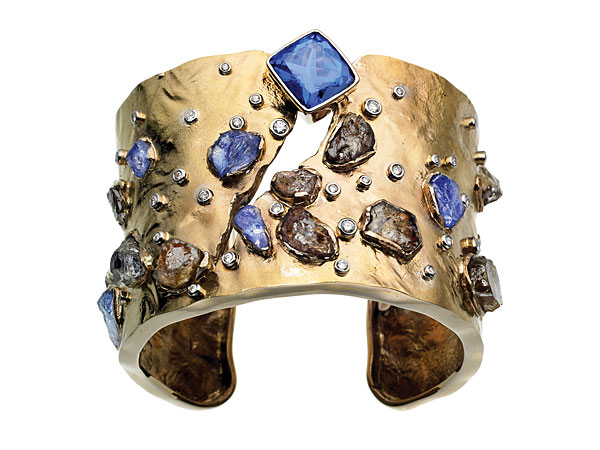 A stunning design from Ginny Dizon, incorporating natural brown and faceted blue tanzanites. A gentle heat treatment turns the brown crystals blue. Photo: Tanzanite Foundation
A stunning design from Ginny Dizon, incorporating natural brown and faceted blue tanzanites. A gentle heat treatment turns the brown crystals blue. Photo: Tanzanite Foundation
Tanzanite is trichroic, meaning it shows different colors when viewed in different directions. One direction is blue, another purple, and the other bronze. When found in the ground, the bronze color often dominates. However, with gentle heating (~520°C), one can watch the blue and violet bloom and deepen in the stone. The resulting color is completely stable.
Legend has it that the effect of heat was first discovered when brown zoisite crystals exposed on the surface were caught in a fire set by lightning that swept across the grass-covered Merelani hills. The Masai herders who drive cattle in the area noticed the beautiful blue color and picked the crystals up, becoming the first tanzanite collectors.
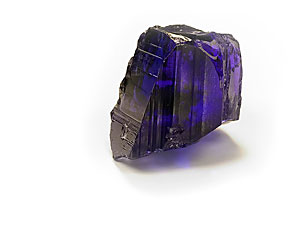
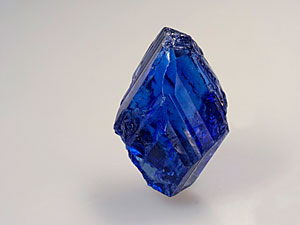
Tanzanite is strongly pleochroic, as the above two photos of the same crystal show. Photo: Wimon Manorotkul/Pala International; specimen courtesy of William Larson
Owing their color to traces of the element vanadium, cut stones with more blue than violet tend to be more expensive because the crystals generally form with the blue color axis oriented along the width of the crystal instead of the length. That means that if the cutter chooses to maximize the purity of the blue color, the stone cut from the rough will be smaller and thus cost more per carat. The blue color, however, is so beautiful that the sacrifice is often worth it.
Rarely, stones of a green color are also found. These are particularly valued by collectors.
Cauldron of gem creation
Proclus in his book of Sacrifice and Magick, saith, That the antient Priests were wont to mix many things together, because they saw that divers Simples had some property of a God in them, but none of them by it self sufficient to resemble him. Wherfore they did attract the hevenly influences by compounding many things into one, whereby it might resemble that One which is above many. J.B. Porta, 1658, Natural Magick
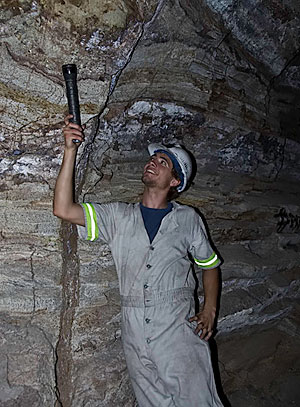
TanzaniteOne's Chief Geologist, Robert Grafen-Greaney, points out the boudins where tanzanite is found. Photo: Richard W. Hughes
Lying in the shadow of Mount Kilimanjaro, the world’s only commercial tanzanite mines have resulted from massive tectonic activity that created one of the most highly mineralized zones in the world — the Mozambique Orogenic Belt.
Tanzania’s gem deposits are a product of this belt, which cuts a 200–300 km-wide north-south swath through the central and eastern part of the country. Running all the way from Mozambique in the south, to the Sudan and Ethiopia in the north, it is home to many of East Africa’s most important colored gemstone finds.
Rocks in this belt underwent several different cycles of tectonism, as well as extensive metamorphism, plutonism, folding and faulting. The metamorphism produced granulite complexes, which, when combined with major crustal movements, formed a witch’s brew of unusual minerals and color varieties. In the granulitic cauldron, pressure and hot fluids cannibalized minerals for their chromophores — vanadium, chromium, manganese — where they were absorbed by existing minerals. At other times, minerals were simply dissolved and built anew. The result is one of the richest gem belts on the planet.
Tanzanite is recovered from pegmatitic veins that have become so stressed they have broken into smaller pieces known as boudins. Gems are found in small pockets within the boudins.
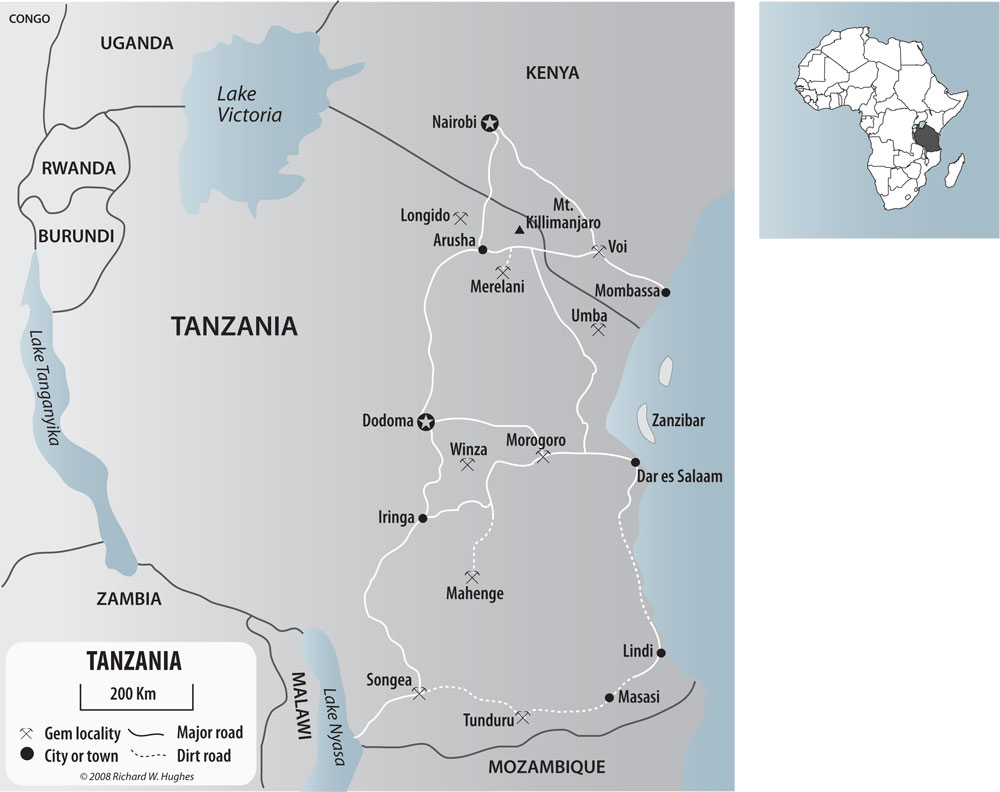 Map of Tanzania and southern Kenya, showing the major gem localities. The tanzanite mines of Merelani are located just south of Mt. Kilimanjaro. Map: R.W. Hughes
Map of Tanzania and southern Kenya, showing the major gem localities. The tanzanite mines of Merelani are located just south of Mt. Kilimanjaro. Map: R.W. Hughes
Originally tanzanite could easily be collected on the surface, but this scavenger mining quickly gave way to pits and now tunnels, some of which extend hundreds of meters beneath the surface.
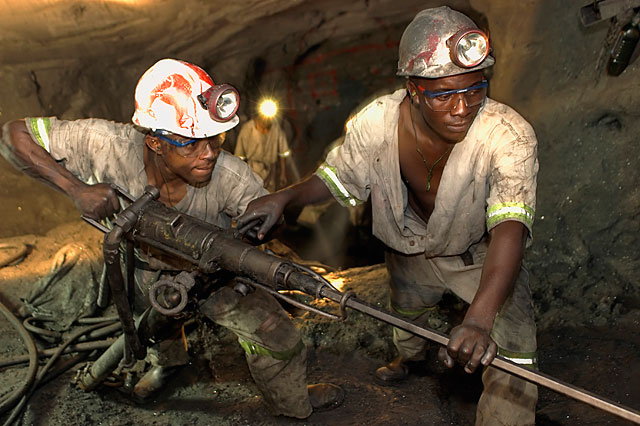 Miners work the face in TanzaniteOne's Block C mine. The extraction process begins with brute force, but ends with the utmost care to avoid damaging the gems. Unlike the other blocks, mining conditions at Block C are excellent and the company has a fine safety record. Photo: TanzaniteOne
Miners work the face in TanzaniteOne's Block C mine. The extraction process begins with brute force, but ends with the utmost care to avoid damaging the gems. Unlike the other blocks, mining conditions at Block C are excellent and the company has a fine safety record. Photo: TanzaniteOne
TanzaniteOne
I couldn't help asking him once what he meant by coming here at all. 'To make money, of course. What do you think?' he said scornfully. Joseph Conrad, Heart of Darkness
While Tanzania's tanzanite mines were discovered by a native Tanzanian, the potential wealth quickly attracted outsiders. These included a variety of characters, both Tanzanian and foreign, who pushed the original discoverer out. Soon the Merelani hills were awash with thousands of fortune seekers and chaos ensued. In 1971, the tanzanite mines were nationalized, but production over the next 20 years was erratic, due to haphazard mining and theft. By 1989, an estimated 30,000 artisanal miners were working in the area.
In 1990, the Tanzanian government curbed artisanal mining and demarcated the area into four blocks: A, B, C and D. Block A was awarded to Kilimanjaro Mines Limited, Blocks B and D to small-scale miners and Block C to Graphtan Limited, a graphite mining company. Graphtan ceased mining activities in 1996 and Afgem acquired the mining licence for Block C. In 2000, Afgem completed a feasibility study for the commercial mining of tanzanite and mine development commenced in 2001. In 2004, the TanzaniteOne Group, a publicly-traded company, acquired Afgem's tanzanite business and assets.
Merelani's tanzanite mines lie within a slender strip of ground, just two km deep by eight km wide. This is Tanzania's most important gem mining area, with as many as 70,000 people supported by those mining, cutting and trading tanzanite in Merelani, Arusha and beyond. 5000 to 6000 miners are said to work at Block D alone, which is the area where the deepest tunnels are found, as the deposit trends down from Blocks A through D.
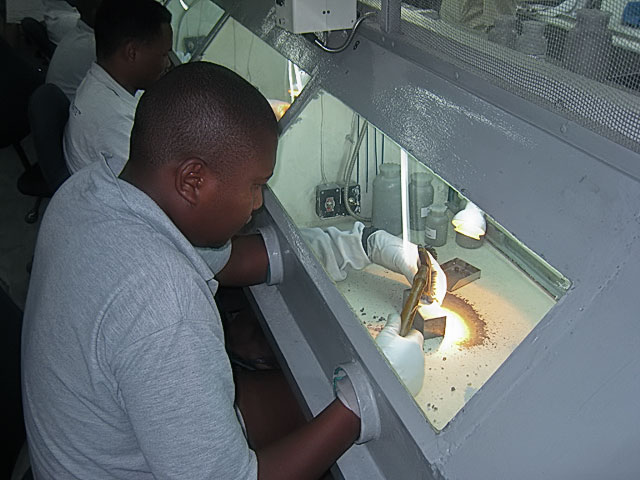 Sorters cobbing rough at TanzaniteOne's sorting room. Women previously did this job, but after one was found secreting gems in a body cavity and a general search of the room turned up over seven kilos of rough hidden in caches of both the human and man-made kind, the job was given over to men. Today, the overseeing is performed by ex-Gurkha soldiers from Nepal. Photo: Richard W. Hughes
Sorters cobbing rough at TanzaniteOne's sorting room. Women previously did this job, but after one was found secreting gems in a body cavity and a general search of the room turned up over seven kilos of rough hidden in caches of both the human and man-made kind, the job was given over to men. Today, the overseeing is performed by ex-Gurkha soldiers from Nepal. Photo: Richard W. Hughes
The TanzaniteOne mine is impressive, to say the least. Indeed, the entire operation exudes class, from the mining conditions underground to the promotional efforts of the Tanzanite Foundation, a non-profit dedicated to promoting tanzanite and assisting the people who mine it. Having observed colored gem mining operations around the world, we must say that the rest of the industry has much to learn from their approach. Does this sound like gushing? We hope so, for they have earned it.
And yet TanzaniteOne faces the dilemma that, no matter how much good work they do, no matter how many schools they fund or roads they build, no matter how much they promote tanzanite as a whole, they will always be regarded with suspicion. The locals understand that, like Joseph Conrad's Kurtz in Heart of Darkness, they have come to this land solely to make money. When the profit is gone, they will leave. Native Tanzanians are different. This is their land, their home. Even if the money is gone, they will remain. They have nowhere else to go.
The road to somewhere
Kilimanjaro Airport lies some 50 km from Arusha. A further 16 km along a small dirt road brings you to the world's only significant tanzanite deposit. Whirlwinds swirl lazily on the dusty plain as one heads into the Merelani hills, carrying you straight into the blue heart of tanzanite.
Along the way, a sign reveals: "This road has been proudly built, sponsored and maintained by the Tanzanite Foundation."
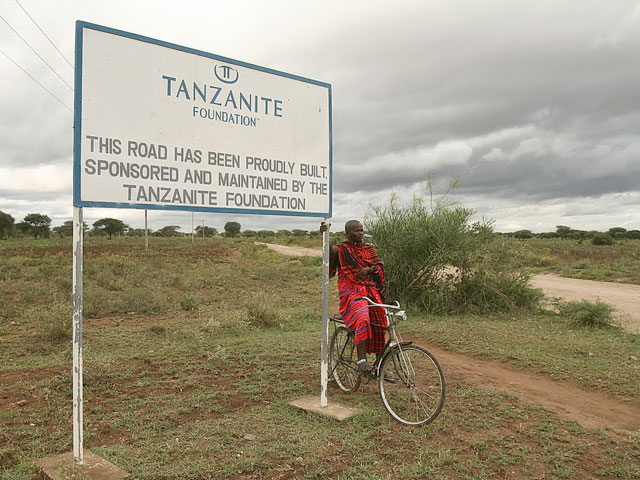 A Masai next to the sign and road to Merelani. Photo: Tanzanite Foundation
A Masai next to the sign and road to Merelani. Photo: Tanzanite Foundation
As we passed, a local member of our party declared the billboard an insult. "Look at this road," he snorted. "Dirt! With all the money they are making, why isn't it tarmac [paved]?"
Hmmm… We countered that, while it was unpaved, it did happen to be graded and was as good as any unfinished road in the country. Indeed, in the three weeks we had spent traveling around Tanzania, we had seen far worse.
Then a discussion began on the cost of paving roads. We suggested that such pavement was quite expensive, but that if the Tanzanian government felt a paved road in this place was important, they could simply raise the royalties on TanzaniteOne to pay for it. This brought laughs all around; even the original doubting Thomas had to admit that, if the rent were raised, not a single shilling would make its way to Merelani for road improvement.
The conversation was brought to a rapid halt by an incredible thump. We had just turned off the road maintained by the Tanzanite Foundation and were now on the "regular road" to Merelani. These few kilometers were as rough as anything we had suffered in Tanzania.
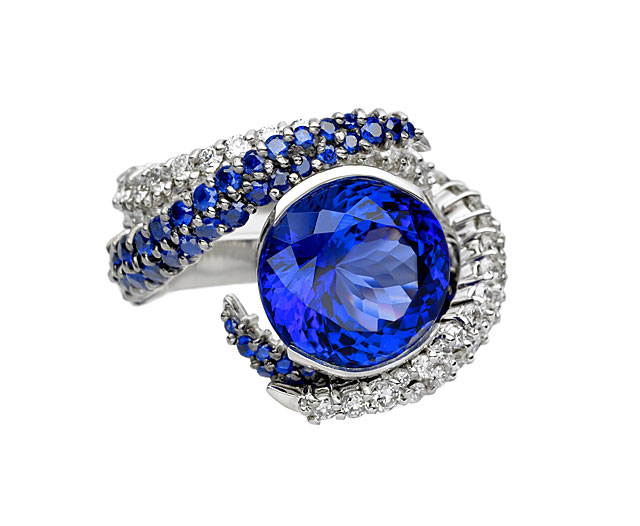 The Tanzanite Foundation, a non-profit started by TanzaniteOne, has spent great effort promoting tanzanite around the world, including sponsoring the creation of exceptional pieces designed by some of the world's finest designers. The above ring was designed by Shaun Leane. Photo: Tanzanite Foundation
The Tanzanite Foundation, a non-profit started by TanzaniteOne, has spent great effort promoting tanzanite around the world, including sponsoring the creation of exceptional pieces designed by some of the world's finest designers. The above ring was designed by Shaun Leane. Photo: Tanzanite Foundation
The blue streets of Merelani
Strength is just an accident arising from the weakness of others. Joseph Conrad, Heart of Darkness
Driving towards TanzaniteOne's Block C mines, we inquired as to the possibility of visiting Merelani and the other operations; before we could even finish the sentence, a curt "no" was expelled by the company's driver.
Up on the hill, we took up the question with a higher authority, namely TanzaniteOne's Managing Director, Zane Swanepoel. Brows furrowed and, amidst hushed whispers, the possibility was discussed. The question was not so much that of hiding the dark side, but more one of physical safety. Not just ours, but that of the TanzaniteOne staff who might take us into the lion's den. In the end, discretion ruled. We would have to seek an alternative guide to visit Merelani's blue streets and indigo pits.
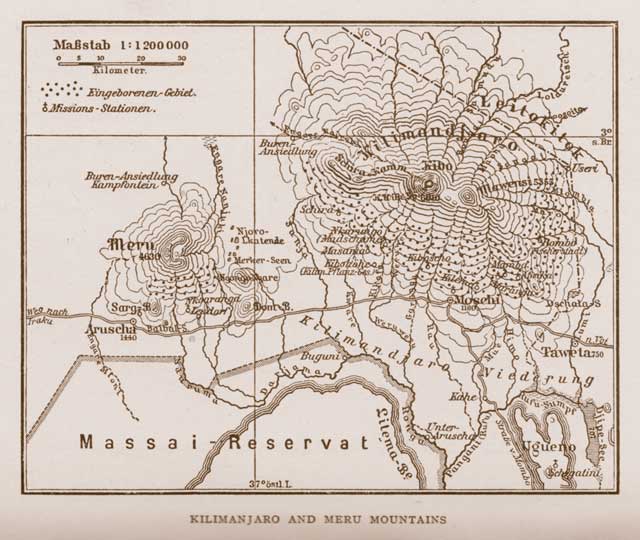 Early 20th century map of the Kilimanjaro area. The peak is easily visible from Merelani’s tanzanite mines. From Calvert (1917); courtesy of Pala International.
Early 20th century map of the Kilimanjaro area. The peak is easily visible from Merelani’s tanzanite mines. From Calvert (1917); courtesy of Pala International.
Heart of Darkness
…and for to seeke out gemmes and some little stones, we strike pits deep within the ground. Thus wee plucke the very heart-strings out of her and all to weire on our finger, one gemme or pretious stone, to fulfill our pleasure and desire. How many hands are worne with digging and delving, that one joint of our finger might shine againe. Surely if there were any devils or infernal spirits beneath, ere this time verily these mines for to feed covetousness and rowt would have brought them up above ground. C. Plinius Secundus, 23–79 AD
The Historie of the World
Several weeks later, our visit to Block D began in humble fashion, with a trip to the mining office to seek permission to tour the mines. Driving through the Merelani streets, it was clear we were a long long way from the mine on the hill. Saloons, pool halls — houses of worship, houses of whoreship. Like mining towns around the world, Merelani was equal parts sin and sincerity.
Guide and permit in hand, we drove to Block D, skirting the razor wire boundary of TanzaniteOne. In numerous places, intruders had cut the fence. It was clear we were riding the border of two entirely different worlds — First and Third — with those on one side not content to stay put.
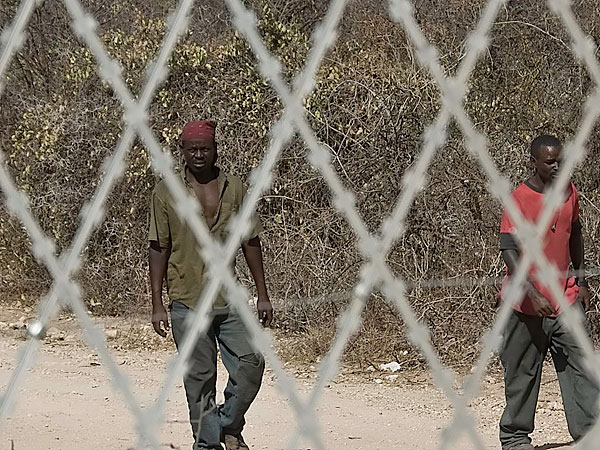 Not unlike the fence that separates Tijuana from San Diego, razor wire divides the different mining blocks at Merelani. And just like the US-Mexico border, there are repeated signs of breaches as those from the Third World claw their way towards the First. Photo: Richard W. Hughes
Not unlike the fence that separates Tijuana from San Diego, razor wire divides the different mining blocks at Merelani. And just like the US-Mexico border, there are repeated signs of breaches as those from the Third World claw their way towards the First. Photo: Richard W. Hughes
Into the abyss
Merelani's Block D is a hodgepodge of hundreds of small claims stuffed into a few hundred square meters like bunks in a Hong Kong flophouse. Each claim is surrounded by barbed wire-topped tin siding. Arriving at the Kikuyu Mine, the gate was eased open and quickly slammed shut behind us. TanzaniteOne's mine was not the only one where claim-jumping was a problem. Indeed, in these "native blocks", the intrusions often come deep underground. Down in these indigo tunnels, survival trumps political boundaries.
In this small compound, sixty miners were working underground in teams of thirty, in six-hour shifts. The mine manager, Nixon Monga, was our gracious host. Since the death of his father nine years before, this 24-year old managed the mine with the help of two partners. He told us that, over the past two years, hardly any stones had been found, with the work becoming more and more difficult as the tunnels reach ever deeper into the earth.
 Kikuyu Mine owner, Nixon Monga, in Merelani's Block D tanzanite mine. Photo: Richard W. Hughes
Kikuyu Mine owner, Nixon Monga, in Merelani's Block D tanzanite mine. Photo: Richard W. Hughes
As our guides began wrapping their faces with bandanas, we were told the main shaft begins with a vertical drop of some 100 meters deep, accessed by a wooden ladder. This then connects to several anorexic-sized tunnels that, after some 200–300 m, would bring us to the current mining face.
Hmmm... At this point the adults of the group (RWH and MC) suggested that someone would certainly be needed to call a doctor should an accident arise. They quickly volunteered, and remained topside, ever vigilant.
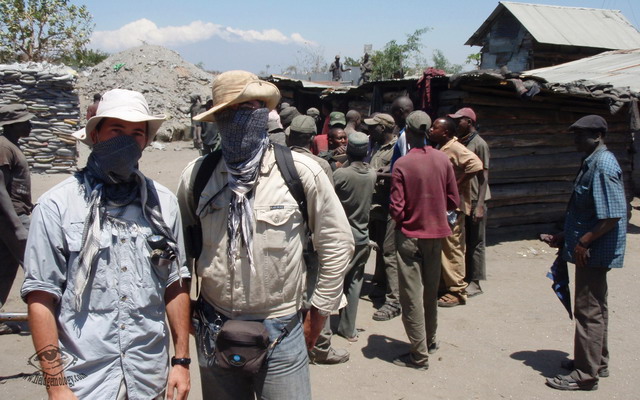 The Merelani Mob. Guillaume Soubiraa and Vincent Pardieu prepare to plumb the blue depths at Merelani's Block D. Photo: Vincent Pardieu
The Merelani Mob. Guillaume Soubiraa and Vincent Pardieu prepare to plumb the blue depths at Merelani's Block D. Photo: Vincent Pardieu
After several members of our party disappeared down the rabbit hole, the occasional miner emerged from the indigo depths, coated head to foot in graphite dust. Following six hours underground, they ran for the fence, rushing to purchase a small bottle of milk or water. It was clear that the conditions underground were desperate.
We waited more than two long hours for our friends' return. Finally, as the sun was beginning to set on Mount Kilimanjaro, black ghosts crawled from the hole and collapsed on the ground. Dripping with sweat and coated in graphite, they needed several minutes simply to be able to stand and speak.
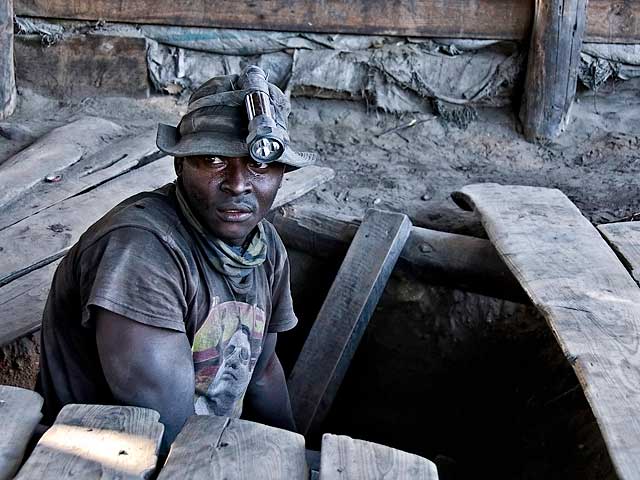 A graphite-coated miner emerges from the shaft at Merelani's Block D. Photo: Richard W. Hughes
A graphite-coated miner emerges from the shaft at Merelani's Block D. Photo: Richard W. Hughes
The scene they described was one straight from Hades. A vertical descent began with a hundred meters on a ladder, but in several places it was possible to rest a bit. With no rope or hard hat, one could only pray that nobody above would fall during the descent, for that would mean certain death for all unfortunate enough to be on the ladder below.
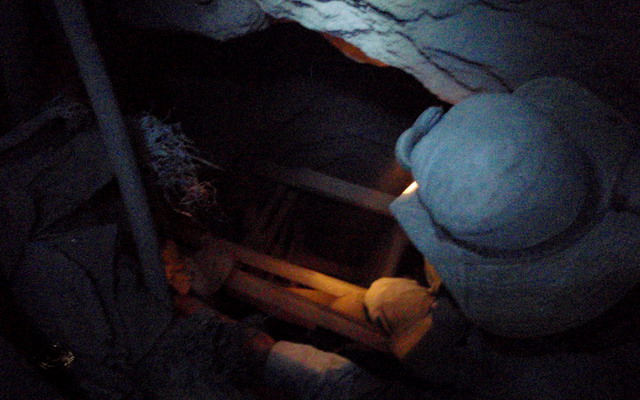 Down, down…
Down, down…
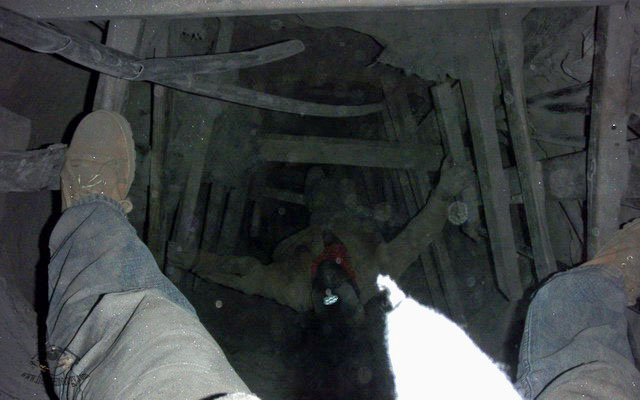 …down we go. Photos: Vincent Pardieu
…down we go. Photos: Vincent Pardieu
Arriving at the bottom of the vertical pit, one was then forced to crawl within tunnels that, while roughly horizontal, squirmed up and down in an irregular fashion. The task was all the more difficult for the tallest of us, as these passages were no more than a meter high, meaning we were not even able to crawl on hands and knees, but were forced to slither like snakes on our bellies. Impromptu meetings with miners passing in the opposite direction left each party feeling like a rape victim, covered in the sweat and grime of the other.
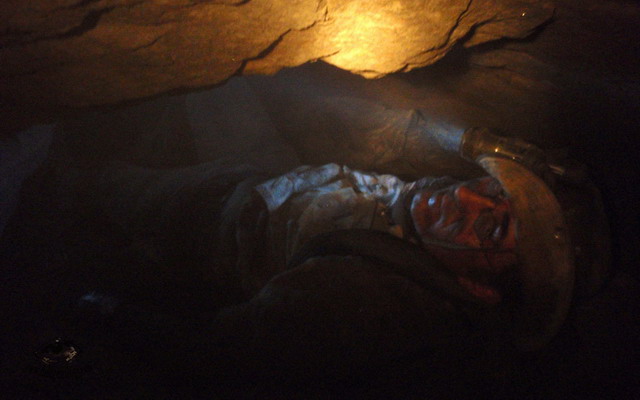 Vincent Pardieu exploring the Merelani labyrinth. Working the blue seam often involves moving through incredibly tight spaces, where enough wiggle room can literally be the difference between life and death. Photo: Guillaume Soubiraa
Vincent Pardieu exploring the Merelani labyrinth. Working the blue seam often involves moving through incredibly tight spaces, where enough wiggle room can literally be the difference between life and death. Photo: Guillaume Soubiraa
So dense was the graphite-laden atmosphere that we soon removed our masks, as breathing carbon was found more pleasant than not breathing at all. We now understood why miners were unwilling to wear helmets: the tunnel was solid rock and so narrow that wearing a helmet would rapidly become annoying. Hard hats and masks are simply a hindrance when crawling like a rat in such narrow spaces.
After visiting secondary galleries, we arrived at the main mining area, which was wider and slightly higher than the approach. A pleasant surprise was a hole from which cold air from the surface poured in. It was a pure wonder to breathe fresh air after an hour spent inhaling hot graphite.
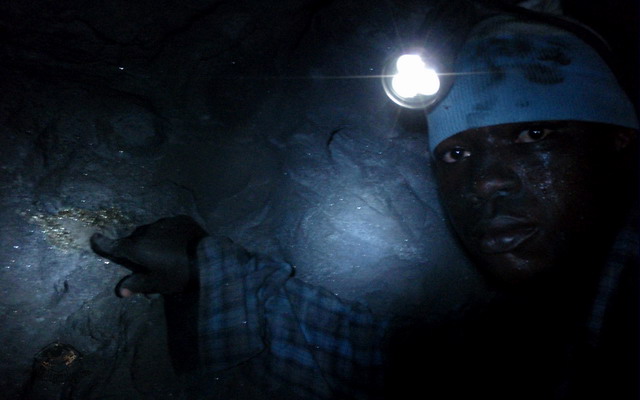 Tanzanite seams often feature a mixture of calcite and pyrite. Photo: Vincent Pardieu
Tanzanite seams often feature a mixture of calcite and pyrite. Photo: Vincent Pardieu
At the working face, the men described what they were doing, excitedly pointing to veins they were mining, following the pyrite and graphite. We could see in their eyes the excitement and only then did it become clear what was motivating them to work under such extreme conditions. Their fuel was hope — hope to hit a gem pocket — hope to become rich like the others had — hope to escape from this carbon-laced tomb. They struggled to explain that, in their village or city slum, they had no chance at a future. But here, deep underground, with hard work and a bucketful of luck, they just might get enough money for a better life. We thought to ourselves that hope was a cruel mistress, but she was the only lady who would have them.
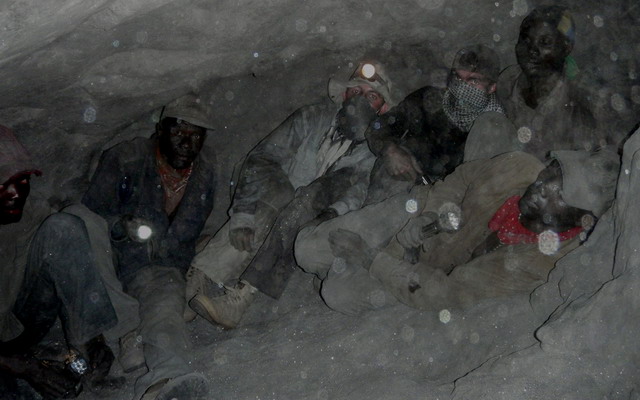 Guillaume Soubiraa and Philippe Brunot in the tight confines of a tanzanite mine at Merelani's Block D, along with local miners. Photo: Vincent Pardieu
Guillaume Soubiraa and Philippe Brunot in the tight confines of a tanzanite mine at Merelani's Block D, along with local miners. Photo: Vincent Pardieu
After hours underground, we began the long trip to the surface. Going up was much more difficult than going down. The tunnels were dry, dusty, parched with graphite. Many times we had to stop simply to be able to breathe. The miners helping us smiled, explaining that this was normal for the first time, but we would get used to it. Could people really get used to this?
Eventually we reached the wooden ladder and began to climb. By now, exhaustion had set in and the only focus was on not falling. Meter by meter we ascended towards the blue city, towards the sky. The air was becoming better and as we looked up, a tiny circle of light appeared, shining like an entry hole cut into heaven. Step by step we climbed, the circle growing ever larger. Now we, too, had made hope our mistress, and the soft touch of her skin was just within reach. Just a few more steps…
Black ghosts emerged on the surface and collapsed, gasping for breath, without the strength even to hold the waiting water to their lips. The miners were smiling and laughing. Within a few hours they would go down again, not to visit, but to work, to break rocks in their search for a little bit of hope, a fragment, a circle of light in a black world. All so that, in the words of Pliny, "…one joint of our finger might shine." Hard work so that a man in a distant land can offer a lovely stone to the woman of his dreams. Hope and hard work turned into love and cash? Yes, this is tanzanite… in the best case.
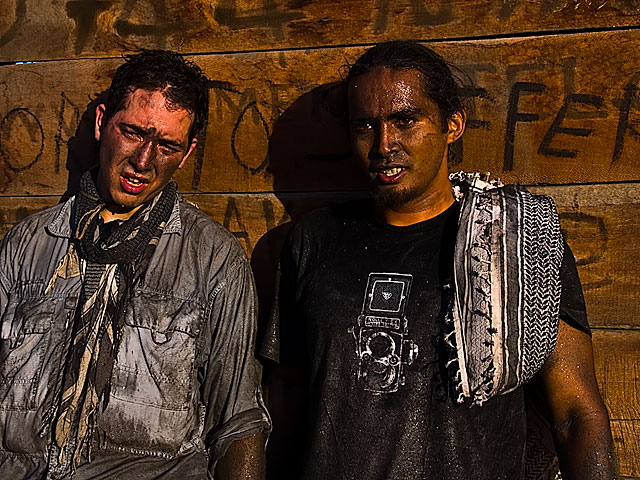 The color of exhaustion. Guillaume Soubiraa and Michael Rogers shortly after emerging from the Merelani labyrinth. Photo: Richard W. Hughes
The color of exhaustion. Guillaume Soubiraa and Michael Rogers shortly after emerging from the Merelani labyrinth. Photo: Richard W. Hughes
The working hour
Why is gold worth some twenty bucks an ounce? A thousand men, say, go searchin' for gold. After six months, one of them's lucky…. His find represents not only his own labor, but that of 999 others, to boot. That's 6000 months, 500 years, scramblin' over a mountain, goin' hungry and thirsty. An ounce of gold, mister, is worth what it is because of the human labor that went into the findin' and the gettin' of it. Walter Houston, Treasure of the Sierra Madre, 1948
Let's make this clear. We have spent years visiting gem mines across the world and have borne witness to scenes of tremendous hardship. But on that October afternoon, none were prepared for the spectacle that unfolded as we watched miners crawl from the graphite-laced depths of Merelani. Gasping for air, covered with sweat, as they emerged from below and the sun's rays struck their skin, they sparkled. Sparkled! Each miner had, in a macabre sense, become a jewel. Shining, shimmering, glittering.
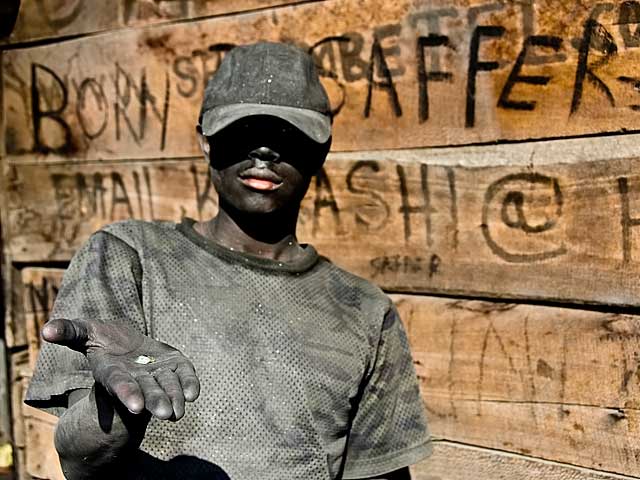 Born to Saffer
Born to Saffer
A graphite-coated tanzanite miner sparkles in the sun at Merelani's Block D, a small fragment of pale green diopside his only reward for six hours underground. Photo: Richard W. Hughes
Of course, this beauty was temporary, a coiled serpent before the strike, mercury flowing slowly across the skin, venom seeping into the bloodstream.
We understood what that shimmer meant. And so did each miner. It was a long slow fuse, a poison that would eventually kill them. To couch it in terms any less harsh would not simply be a lie, but something far worse — the final denial of the humanity of those who have eyes and — since birth — thrown snake-eyes.
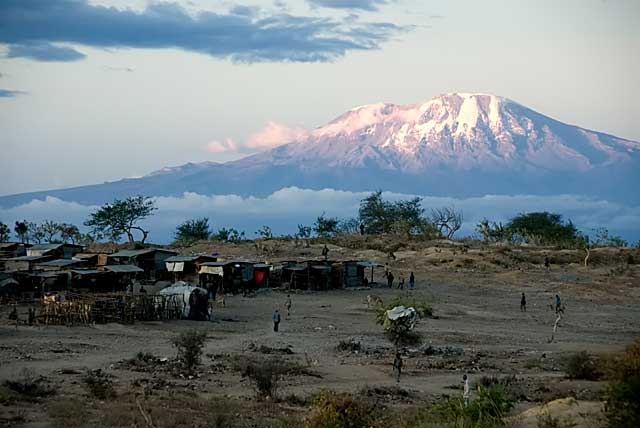
The snows of Kilimanjaro rise in majestic splendor from Merelani's tanzanite mines. This ice-capped dormant volcano is not just Africa’s highest peak, but at 5,895 meters (19,340 ft), also one of the world’s tallest freestanding mountains, rising from farmlands through lush rainforest to alpine meadows and, finally to the snowcapped twin summits of Kibo and Mawenzi. While known to Africans from time immemorial, in the sixth century Chinese mariners reported a “great mountain” inland. It did not enter European knowledge until 1849 when a German missionary, Johannes Rebmann, reported a snow-capped peak just three degrees below the equator. According to Chagga tribal legend related to King Solomon’s mines, a great treasure is said to exist on the mountain, protected by powerful spirits ready to punish any foolhardy enough to dare climb it. Photo: Richard W. Hughes
Final call
There are those who suggest that the world's ills can be cured by decree or embargo. That if only the enlightened beings of the enlightened nations would unite, suffering can be wiped out. Child labor? Ban it! Unsafe working conditions? Ban 'em! China? Pressure! Iran? Sanctions! Boycott, embargo, repress, subterfuge, infiltrate. And when those techniques are not enough? Send in the drones and jackals for revolution.
We ask you this: Which is more sad — the conditions under which the world's poor eke out an existence, or the self-righteousness of those who have no direct experience with the problem, but profess an understanding of the solution. Just who is lacking enlightenment?
Next time you set eyes on a tanzanite, a jade, a ruby, a diamond, or — dare we say it — a cell phone, understand where it comes from. It is not just of the earth, but also from the blood and sweat of thousands of fellow humans, each in their own way struggling forward in life, trying to make things a little bit better for themselves and their families. The Merelani miner is no different than a Dar es Salaam cabbie fed a daily diet of pollutants or a bush hunter braving tsetse flies and the black mamba.
They ask but little of us. Like the jade digger in Burma, the Bangkok tuk-tuk driver or the Appalachian coal miner, these people — through accident of birth or otherwise — toil at the margins. They understand exactly what they face. They do not seek nor need pie-in-the-sky idealism. No tomorrow today. Just a leg up. A helping hand to make the present a little bit better. Just a little bit of hope.
Wanna make a difference in their lives? Buy what they are risking their lives to produce. Now how's that for activism? How's that for revolution?
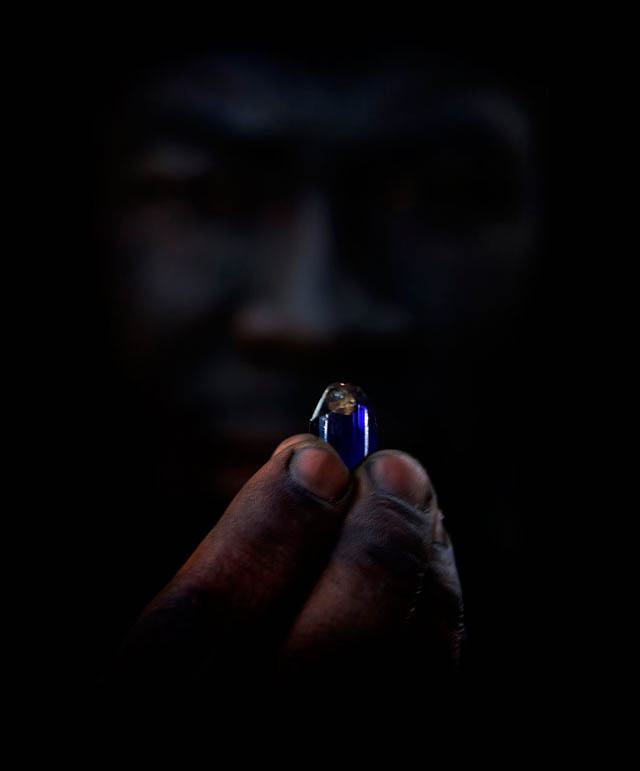
Postscript — A mistress called Hope
No fear can stand up to hunger, no patience can wear it out, disgust simply does not exist where hunger is; and as to superstition, beliefs, and what you may call principles, they are less than chaff in a breeze. Joseph Conrad, Heart of Darkness
Several months following our departure, heavy rains swept across Tanzania. A number of the Merelani tanzanite mines were flooded and, tragically, many died, trapped deep underground.
With such situations, blame is never in short supply. Why didn't the mine owner institute better standards? How were miners allowed to go underground when they knew conditiions were unsafe? For Pete's sake, in today's world, why does such suffering exist?
The answer is quite simple. This world is not perfect. It never has been and never will be.
As we read of these tragedies, we were reminded of crawling through the terrible tanzanite tunnels. What if? Instead of being dry, what if these shafts had instead been drenched with rain? What if? It is simple. We might have experienced the serpent's strike. When we learned of the tragedy, we had no difficulty imagining what the miners' last moments must have been like.
Despite the deaths, miners continue to descend into Merelani's depths in search of tanzanite. Incredible stones, incredible conditions and such incredible men. Words are not enough to describe the courage of these men. People like Izrael Deo and Tobias Stanslaus, the two who took us down into their world and brought us back alive. Izrael, a young educated Tanzanian, spoke good English. He told us that he decided to quit school and go mining with his father because he wanted to get money, to earn enough for a good life in the future. Izrael and Tobias, we wish you all the best. You shine more brightly than any jewel you might unearth.
Having experienced firsthand the conditions under which tanzanite is mined gives us a new-found respect. No longer when we view tanzanite do we do simply see a blue stone. Instead, when gazing into its azure depths we see the soldiers who work the blue seam. While some might see them singing the blues, we now hear their song, we look towards their mistress. Her name is Hope. She is just out of reach, but soon we will feel her soft skin. Just a few more steps…

Tanzanite references & further reading
- Bank, H. (1971) Über einige Edelsteine aus Tansania und ihre Vorkommen. Hessisches-Landesamt für Bodenforschung, Abhandlungen, Vol. 60, pp. 203–215; RWHL.
- Bank, H. (1971) Edelsteinvorkommen in Afrika. Afrika-Spektrum, No. 2/1970, pp. 96–110, 124–127; not seen.
- Bank, H., Berdesinski, W. et al. (1967) Strontiumhaltiger trichroitischer Zoisit von Edelsteinqualitat. Zeitschrift der Deutschen Gesellschaft für Edelsteinkunde, Vol. 61, pp. 27–29; not seen.
- Barot, N.R. and Boehm, E.W. (1992) Gem quality green zoisite. Gems & Gemology, Vol. 28, No. 1, Spring, pp. 4–15; RWHL*.
- Bassett, A.M. (1993) Gemstones of East Africa [book review]. Gems & Gemology, Vol. 29, No. 3, Fall, p. 217; RWHL.
- Bridges, C.R. (1982) Gemstones of East Africa. In International Gemological Symposium Proceedings, Santa Monica, CA., Gemological Institute of America, pp. 266–275; RWHL*.
- Calvert, A.F. (1917) German East Africa. London, T. Werner Laurie, Ltd., 122 pp., 219 plates; seen.
- Conrad, J. (1999) Heart of Darkness. Penguin great books of the 20th century, New York, Penguin Books, 146 pp.; first published 1902; RWHL*.
- Dirlam, D.M., Misiorowski, E.B. et al. (1992) Gem wealth of Tanzania. Gems & Gemology, Vol. 28, No. 2, Summer, pp. 80–102; RWHL*.
- Eliezri, I.Z. and Kremkow, C. (1994) The 1995 ICA world gemstone mining report. ICA Gazette, December, p. 1, 9 pp.; RWHL.
- Federman, D. (1988) Modern Jeweler’s Gem Profile: The First 60. Shawnee Mission, Kansas, Modern Jeweler, Photos by Tino Hammid, 131 pp.; RWHL.
- Federman, D. (1990) Consumer Guide to Colored Gemstones. New York, Van Nostrand Reinhold, 253 pp.; RWHL.
- Finke, J. (2006) The Rough Guide to Tanzania. London, Rough Guides, 2nd ed., 816 pp.; RWHL.
- Gübelin, E.J. (1973) Internal World of Gemstones. Zürich, ABC Verlag, reprinted 1983, 234 pp.; RWHL*.
- Gübelin, E.J. and Koivula, J.I. (1986) Photoatlas of Inclusions in Gemstones. Zürich, Switzerland, ABC Edition, revised Jan., 1992; German edition, 1986 (Bildatlas der Einschlüsse Edelsteinen), 532 pp.; RWHL*.
- Gübelin, E.J. and Weibel, M. (1976) Neue Untersuchungen am blauen Zoisit (Tansanit). Zeitschrift der Deutschen Gemmologischen Gesellschaft, Vol. 25, No. 1, pp. 23–32; not seen.
- Hurlbut, C.S. (1969) Gem zoisite from Tanzania. The American Mineralogist, Vol. 54, May–June, pp. 702–709; RWHL*.
- Keller, P.C. (1992) Gemstones of East Africa. Phoenix, Geoscience Press, [with photos by E.J. Gübelin], 160 pp.; RWHL.
- Meen, V.B. (1968) Zoisite—A newly found gem. Lapidary Journal, Vol. 22, pp. 636–637; not seen.
- Oshman, D.C. and Caulton, C. (1979) Colored gems of East Africa. Lapidary Journal, November, p. 1768; RWHL.
- Pliny and Holland, P. (1601) The Historie of the World: Commonly Called the Natural Historie of C. Plinius Secundus. London, Printed by Adam Islip, 2 vols. in 1; seen.
- Porta, J.B. (1658) Natural Magick. London, Thomas Young and Samuel Speed, [1st English translation of 1558 Naples ed., reprinted by Basic Books, New York, 1957], 409 pp.; RWHL*.
- Rwezaura, M. (1990) Known gemstone deposits in Tanzania. Unpublished manuscript, 27 pp.; not seen.
- Sarofim, E. (1970) Gem-rich Tanzania. Lapidary Journal, No. 3, June, pp. 434–439; RWHL.
- Suleman, A., Zullu, A.S. et al. (1994) More gem mining activity in Tanzania. ICA Gazette, December, pp. 3–5; RWHL.
- Thompson, T. (1969) Tanzania to Tiffany's: A semiprecious discovery in East Africa starts a jewel rush. Life, May 9, pp. 70–76; RWHL*.
- Zancanella, V. (2004) Tanzanite: All about one of the most fascinating gemstones. Cavalese, Italy, Naturalis Historia, 120 pp.; RWHL.
Reference key
- RWHL = References in the personal library of Richard W. Hughes
- seen = References seen by RWH
- not seen = references not seen by RWH, but possibly of interest
- * = Denotes works of particular merit
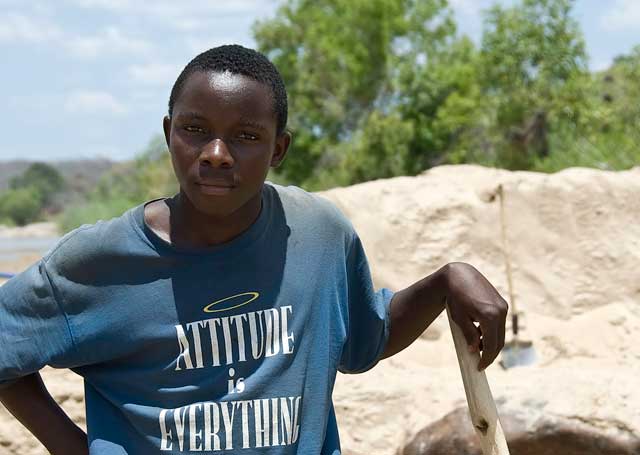 This says it all, doesn't it? Photo: Richard W. Hughes
This says it all, doesn't it? Photo: Richard W. Hughes
Acknowledgments
The authors would like to thank all those who assisted their journey:
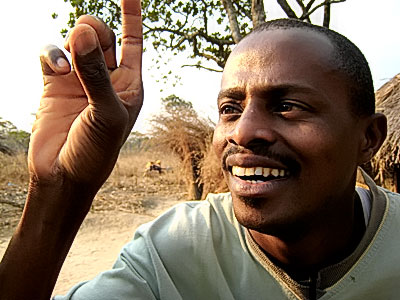
We extend gracious thanks to our guide, Abdul Amsallem, whose knowledge of Tanzania's gem mines is second-to-none. Photo: Richard W. Hughes
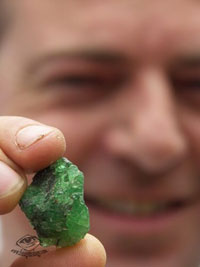
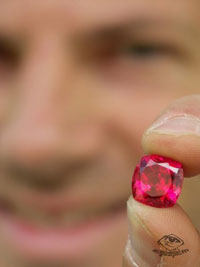
We extend gracious thanks to Mark and Eric Saul of Swala Gem Traders, who did everything in their power to make our journey a successful one. Photos: Vincent Pardieu
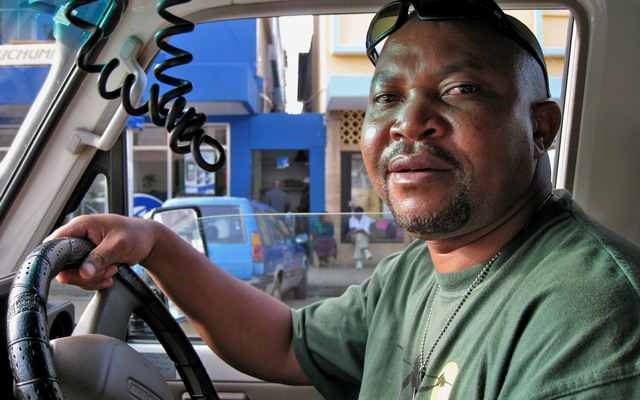
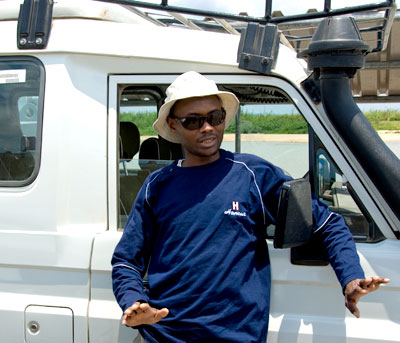
We extend gracious thanks to our drivers, Musa (top) and Abel (bottom), who kept us on the proper path and made sure we did not get into more trouble than we deserved. Photo: Richard W. Hughes
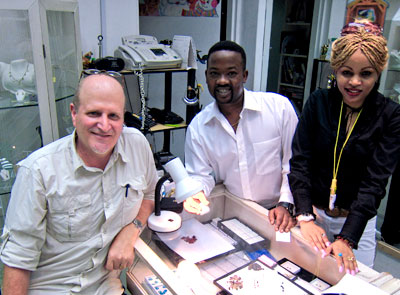
We extend gracious thanks to Kennedy and Susie Kamwathi (center and right) of Kennedy's Gems in Nairobi for all their help with our journey. Photo: Montogmery Chitty.
We also extend our thanks to Nixon Monga, Izrael Deo and Tobias Stanslaus of Merelani's Block D mine.
A very special thanks goes out to Ian Harebottle, Zane Swanepoel, Robert Grafen-Greaney, Gabriella Endlin, Hayley Henning and the rest of the TanzaniteOne and Tanzanite Foundation staff. May all your dreams be true blue!
Meet the Insane Gem Posse…
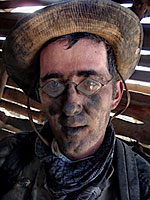
Vincent Pardieu, a self-confessed "travel-addicted gemologist," lives life for the sole reason that, somewhere, someplace, there still exists a hole in the ground he has yet to put his head into. His personal writings and research can be found at www.fieldgemology.org. We are still looking for a twelve-step program for him. Reader suggestions should be submitted to This email address is being protected from spambots. You need JavaScript enabled to view it.. Soap required.

Richard W. Hughes (clean, center) claims to be the author of Ruby & Sapphire and a bunch of other crap he says will be important when "they finally get it." So sweet. A committed conspiracy theorist, Richard believes that life is a plot, designed to trick us into believing we are not already dead. If you happen to know "they" or understand what "it" might be, contact Richard at This email address is being protected from spambots. You need JavaScript enabled to view it.. Anonymous remailer and tin-foil hat required.
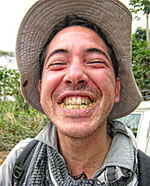
Guillaume "Guji" Soubiraa first became interested in precious stones as a teenager in Madagascar. His interest was rekindled upon meeting VP and RWH in Tana in 2005. Soon he was studying gemology in Bangkok and the rest, as they say, is… uh… we'd better not say. A self-confessed Franco-Mada love-bunny, Guji awaits the day that he can pick up "hot American babes" in Aspen. With a smile like that, who can resist? Snowbunnies who would like to jump some "sexy French bones" can contact him at This email address is being protected from spambots. You need JavaScript enabled to view it.. Toothbrush required.

Michael Rogers is the third-generation of the Rogers family in the gem business, with his grandfather and father being old friends of RWH. His family's company, Rogers Gems, is currently involved in mining in Madagascar (or so they say). Mike is half-Japanese, a quarter Dutch, an eighth Pelé, a bit Indonesian, a sliver Mac, three-thirty-seconds french hen and two hundredths turtle dove. Contact Mike at This email address is being protected from spambots. You need JavaScript enabled to view it.. Toothbrush and partridge in pear tree required.
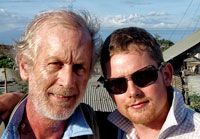
Monty Chitty (left) moved to Aspen, Colorado at the encouragement of his late friend, Hunter S. Thompson. His introduction to the insane gem posse was via cryptic screed to RWH on a sheet of old Rangoon Strand Hotel stationery. A torn fragment of a 45-kyat Burmese banknote, with a brief message stating that someone would soon present the missing half sealed the deal. Monty provided adult supervision, good humor and a welcome shoulder to cry upon when RWH learned his house might be burning down. Contact him at This email address is being protected from spambots. You need JavaScript enabled to view it.. Hip flask and snake venom required.
Warne Chitty (right) began his gemological studies with a trip to Colombia's emerald mines with Ron Ringsrud. Warne now sports a G.G., an F.G.A. and is currently angling for a B.m.F. in Great Britain. His dream job is guiding Guji through Aspen's nightlife scene. Contact him at This email address is being protected from spambots. You need JavaScript enabled to view it.. Prophylactics required.
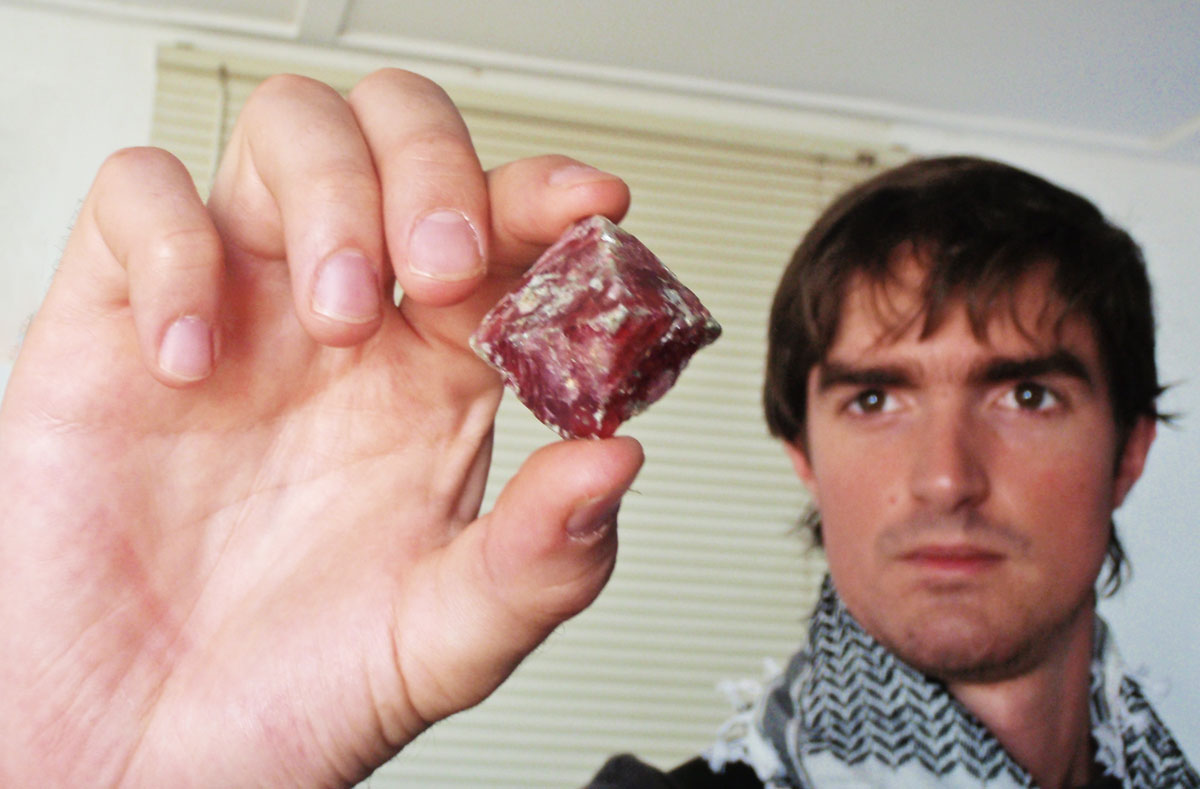
Philippe Brunot is a "budding filmmaker." Budding in that he is still learning Rule No. 1: a broken camera does not a film make. If you can believe this, Philippe slipped and fell while fording Tanzania's Muhuwesi River. Ever the hero, he risked life and limb to keep camera dry, and succeeded. But it still stopped working. Philippe is busy combing the bazaars of East African in search of an HD video camera repair shop. If you know of one, please contact him at This email address is being protected from spambots. You need JavaScript enabled to view it.. Waders required.

Notes
Penned in March–July 2008, following an October 2007 visit to Kenya and Tanzania. This article was the inspiration for Wendell Wilson's superb solo issue of the Mineralogical Record which was completely devoted to Merelani. That issue is the most accurate and comprehensive account of the Merelani mines extant.